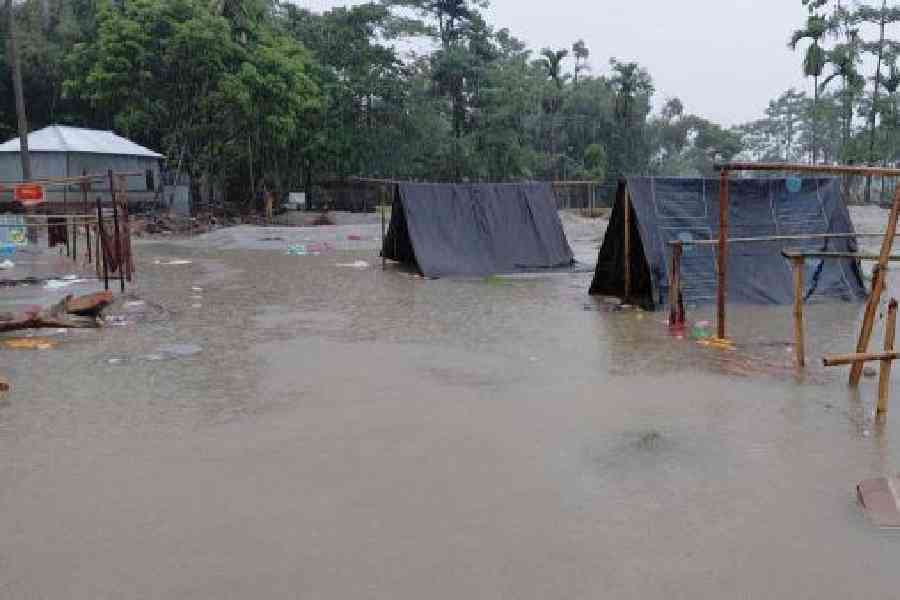Incessant rain triggered by the remnants of Cyclone Montha has thrown life out of gear across the districts of north Bengal and Sikkim over the past 24 hours.
Weather conditions also led to snowfall in the high-altitude areas of Sikkim on Friday, blanketing the mountain slopes in white.
Sources in the India Meteorological Department (IMD) said such weather conditions were expected to continue in most of the districts of north Bengal and neighbouring state of Sikkim for at least another 24 hours.
On Friday morning, snowfall was reported from Lachung in north Sikkim, Nathula on the India-China border and Chhangu (Tsomgo) Lake area, which are in the eastern parts of the mountain state.
“Earlier, snowfall in Lachung was sporadic. But this is the first time in this season that almost the entire area has been covered by a thick bed of snow,” said Kalpak De, a hotelier from Lachung.
Constant rain
In Darjeeling district, uninterrupted rainfall prompted the administration to take preventive measures to ensure people’s safety. Sources said around 20 relief shelters were opened across the hills, where over 100 families took temporary refuge.
In Bijanbari block of Darjeeling, a tree fell on Lizahill Primary School on Thursday night and damaged the roof.

A waterlogged flood shelter after incessant rainfall in Dhupguri block of Jalpaiguri on Friday. Picture by Biplab Basak
Along with north Bengal and Sikkim, rainfall occurred in parts of Bhutan, which in turn led to a rise in water levels of rivers and streams that descend into the Dooars. The Jalpaiguri administration initiated precautionary steps as the area is still recovering from the devastation of the October 5 floods.
Shama Parveen, the district magistrate, said around 3,000 people, including residents of areas affected by the recent floods and those staying near rivers, have been moved to relief camps in advance.
“Community kitchens have been set up for them and officials have been deployed in rain-prone zones to oversee arrangements,” she said.
In Dhupguri block, the Jaldhaka river swelled near Gadheyarkuthi, prompting administrative officials to visit the area on Thursday evening. Public announcements were made asking people to move to safer places.
On Friday again, Shraddha Subba, the SDO of Dhupguri, along with SDPO Galson Lepcha and others, visited Gadheyarkuthi.
Many families, whose homes were destroyed in the earlier floods, had been living in tents on their homestead lands. With renewed rainfall, even those areas became waterlogged, forcing officials to evacuate them again.
Balason swells
The downpour also raised the Balason river at Dudhia on Friday, disrupting direct road connectivity between Mirik and Siliguri four days after it was restored.
The state PWD, which opened a stopgap Hume pipe bridge (vented causeway) over the river on Monday after around 20 days as the old iron bridge got damaged during the October 5 flash floods, halted all traffic over the temporary bridge.
“Due to heavy rain, water levels increased at the Balason. For the safety of passengers and drivers, we’ve suspended traffic over the alternative Hume pipe bridge at Dudhia,” said Anandamoy Mondal, the executive engineer of PWD (roads) posted in Siliguri. “Once the water level recedes, traffic will resume.”
Wet weather forecast
An IMD source said the low-pressure area, a remnant of Montha, lay over northwest Jharkhand and adjoining areas on Friday after moving north-northeast from north Chhattisgarh. It is expected to drift across Bihar and weaken over the next 12 hours. “Favourable wind patterns are likely to cause widespread light to moderate rain and snowfall at higher altitudes, along with heavy to very heavy rain between 70mm to 200mm in parts of north Bengal and Sikkim and heavy to very heavy snowfall between 115.6cm and 204.4cm across parts of Sikkim in the next 24 hours,” the source said.











